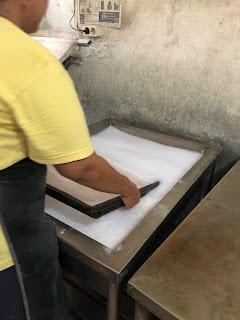Whilst on a holiday in Bali last week I began to wonder if anyone there did paper making.
After a lot of research I came up with only one place, Saraswati Papers. It was started by an Australian, Kali Sali back in 1995 when she realized how much Bali was struggling with an ever growing pollution problem caused by a growing and modernizing society.
Her goal is to reduce the amount of waste so her company collects and recycles papers from hotels, schools, businesses and homes.
As they don't use any bleaches or chemicals to whiten the finished papers the collected papers are then cut so as to keep all the plain white pieces that haven't been printed on to use on their own and those with black and coloured printing are put together for a different type of paper.
The papers are boiled overnight in a large pot.
I loved the Hindu blessing on the side of the stove.

Before being put into a Hollander ) a large beater for paper pulp) to beat the pulp and the water together.


The pulp is then ladled out and placed into a trough and mixed with more water.
The frame is scooped through the water until a fine layer of the paper clings to the mesh.
The frame is then placed onto a board and the water from the sheet is squeezed out before the frame is lifted and the paper stays on the boards.
This is repeated until the boards are full and then they're put out into the sun to dry.
When dry the paper is pulled off the board and stacked ready for using.
Clean white paper.
The Saraswati Papers centre is run by Balinese women from the villages as a way of teaching them paper making skills and giving them an income.
All their papers are 100%post consumer papers and is not only helping the local communities but also the environment as well.








Comments
Post a Comment